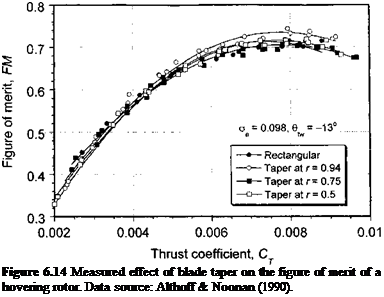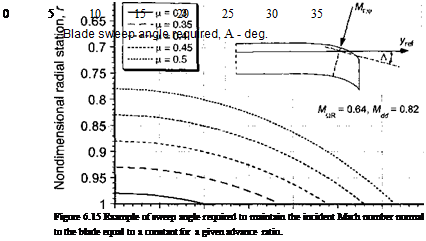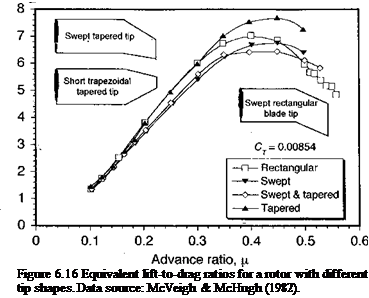Blade Planform and Tip Shape
The tips of the blades play a very important role in the aerodynamic performance of the helicopter rotor. The blade tips encounter the highest dynamic pressure and highest Mach numbers and strong trailed tip vortices are produced there. A poorly designed blade tip can have serious implications on the rotor performance. Figure 6.13 shows some blade tip designs that have been used or proposed for helicopter rotors. There are several common designs, comprising those with taper, those with sweep, and those with a combination of sweep and taper. Some blade tips may also use anhedral, which, as shown by Balch (1984) and others, can improve the figure of merit of the rotor. A good analysis of the effects of anhedral is given by Desopper et al. (1986, 1988), Vuillet et al. (1989), and Tung & Lee (1994). An example of a state-of-the-art tip shape is that on the “advanced growth blade” designed by Sikorsky for the S-92 and later models of the UH-60. This unique tip incorporates all three geometric parameters, sweep, taper, and anhedral. Other special tip designs such as that used on the Westland/RAE BERP blade incorporate somewhat more radical variations in sweep, planform, and anhedral.
![]()

It is known from the analysis in Section 3.4 that blade planform can also have an important effect on the blade lift distribution and, therefore, on the rotor performance. Usually, small amounts of taper over the blade tip region can help to significantly improve the figure of merit (FM) in hover. This is confirmed in Fig. 6.14, which is taken from the subscale rotor experiments of Althoff & Noonan (1990). The benefits, however, seem to be lost for larger amounts of taper, most likely because of the higher profile drag coefficients associated with operation at small tip chord Reynolds numbers (see Fig 7.4). Nevertheless, the experimental results confirm the previous observations from the BEMT that a maximum figure of merit for the rotor can, in part, be obtained by using both a combination of blade twist and taper. The type and amount of taper and twist, however, needs to be factored into the overall rotor design and operational specifications. A 2:1 taper over the tip region seems about optimum for a helicopter blade.
Sweeping the leading edge of the blade reduces the Mach number normal to its leading edge, thus allowing the rotor to attain a higher advance ratio before compressibility effects manifest as an increase in sectional drag and an increase in net rotor power required. The use of sweep also affects tip vortex formation, its location after it has been trailed from the blade, and its overall structure — see, for example, the results of Rorke et al. (1972), Balcerak & Felker (1973), Spivey (1968), Spivey & Morehouse (1970), Carlin & Farrance (1990), Sigl & Smith (1990), Smith & Sigl (1995), and Martin & Leishman (2002). However, the problem of rotor tip vortex formation and the effects of tip shape on the vortex characteristics, such as the velocity profile and the diffusive characteristics, is still the subject of ongoing research; systematic studies of the tip vortex characteristics generated by rotors with different tip shapes have not yet been accomplished. It is likely, however, that this is an area where research may lead to improved tip shapes and rotor blades optimized for lower induced drag.
Blade tips with a constant sweep angle and those with a progressively varying sweep angle have been used. Many modern helicopters (for example, the UH-60 Blackhawk and the AH-64 Apache) use some simple constant sweepback on the blade tip. The amount of sweep is usually kept low enough (< 20°) so that there are no inertial couplings introduced into the blade dynamics by an aft center of gravity or by aerodynamic couplings caused by a more rearward center of pressure. A constant sweep angle offers simplicity in design and construction, but may result in higher than desirable aerodynamic torsional couplings because of the rearward location of the local center of lift.
A blade tip with a progressive sweep angle can be designed on the basis of a simple 2-D blade element analysis. One criteria is to choose a sweep angle that is just sufficient to maintain a constant incident Mach number normal to the leading edge. The velocity normal to the leading edge, Un, is given by
Un = QR (r fi sin V0 cos Л, (6.10)
where A is the local sweep angle of the blade 1/4-chord axis (see inset in Fig. 6.15). The incident Mach number, Mr,^, is then
![]()
 |
QR
Mr Ф = —— (r + /л sin V0 cos Л = Mqr (r + [i sin V0 COS A,
a
where a is the sonic velocity and M^r is the hover tip Mach number. Consider the design point as the advancing blade, that is, where л/г = 90°, and ignore any unsteady effects associated with the problem. If the local Mach number is to be maintained below the drag divergence Mach number, Mdd, then the sweep angle required to do this is given by
![]() (6.12)
(6.12)
For example, assume a typical hover tip Mach number of 0.64, and an airfoil with Mdd = 0.82. Then the sweep angle required to ensure that Mr ^ at each section remains just below Mdd is
![]()
 |
(6.13)
The results are plotted in Fig. 6.15, where it will be seen that the 1/4-chord sweep angle is a smooth, almost parabolic, curve. With increasing advance ratio the amount of sweep required increases substantially and the sweep initiation point moves inboard on the blade. However, the amount of sweep that can actually be used or tolerated on a given helicopter blade clearly depends on structural dynamic issues as well, and such effects must be carefully examined. See also Questions 6.9 and 6.10.
McVeigh & McHugh (1982) have conducted experiments with subscale rotors to study the effects of tip shape on overall rotor performance and cruise lift-to-drag ratio. It was shown that the combined use of improved airfoil sections and tapered tip shapes can help minimize profile power and significantly improve overall cruise efficiency of the rotor. The effects of tip shapes were examined for four rotors having rectangular, swept, swept-tapered, and tapered tips. All rotors were tested at the same lift, propulsive force and trim state, which provides a proper datum for performance comparisons. Figure 6.16 reproduces a summary of the results from McVeigh & McHugh (1982). The tapered tip was found to give about 10% higher equivalent L/D ratio compared to the rectangular blade, but interestingly enough the rectangular blade gave a better maximum cruise LjD ratio than either of the swept or swept tapered blades. This is because both the advancing and retreating blade characteristics of
 |
the tip shape are important, and an integrated performance metric such as L/D ratio does not allow one to distinguish separately between these characteristics. While sweepback alone clearly has the advantage of delaying the onset of compressibility effects to higher advance ratios, the sweep may also promote early flow separation on the retreating blade at lower angles of attack. Therefore, there can be a performance penalty associated with a swept tip.
Yeager et al. (1987) and Singleton et al. (1990) have examined the performance of a tapered blade versus a blade with a simple swept tip and have found improvements in performance, with lower power requirements up to advance ratios of 0.4. Noonan et al. (1992) have examined the effects of blade taper alone on forward flight performance. Generally, small amounts of taper are desirable and help to improve rotor performance, at least up to advance ratios of 0.3. Larger amounts of taper yield much smaller improvements. Yeager et al. (1997) have tested a “BERP-like” (see Section 6.3.8) subscale rotor under similar controlled conditions and have compared the results to a rectangular blade with the same airfoil section. These and the other results confirm that a sophisticated swept tip design is by no means a panacea; each tip design must be assessed on the performance gains to be expected over the full operational envelope as well as within the overall requirements and constraints imposed by the rotor design process.











